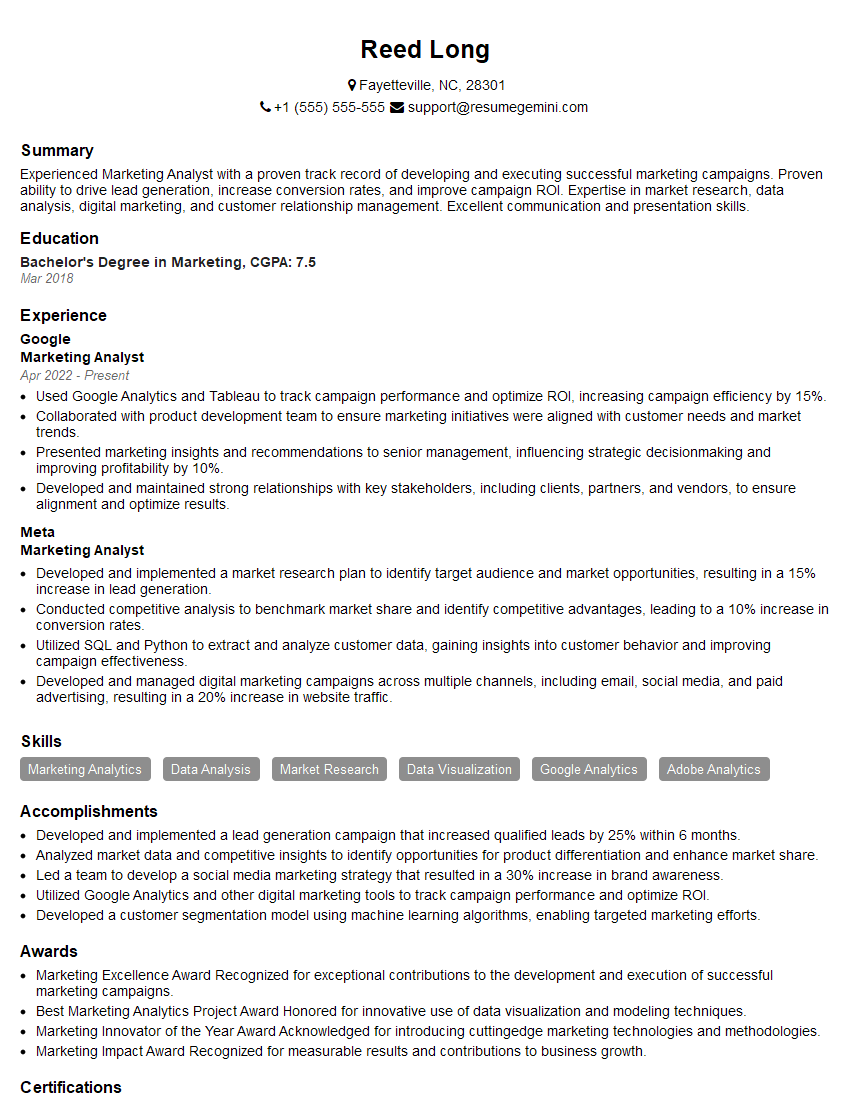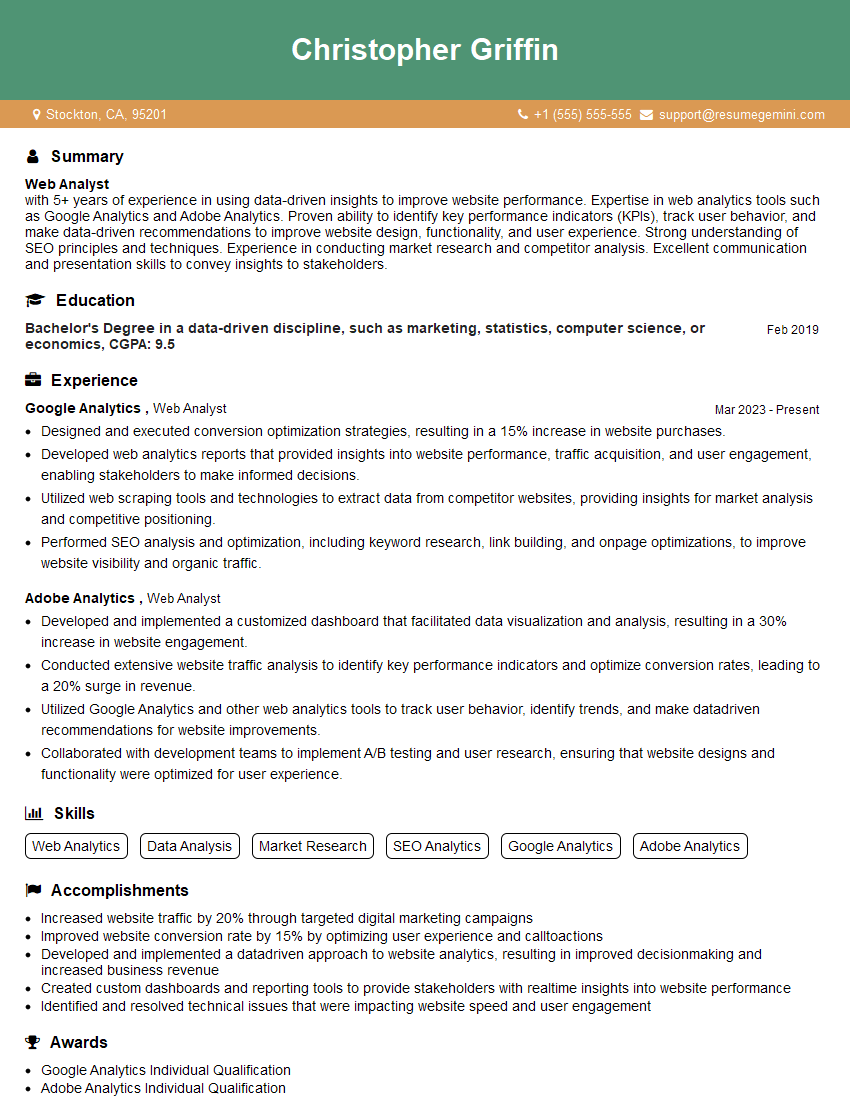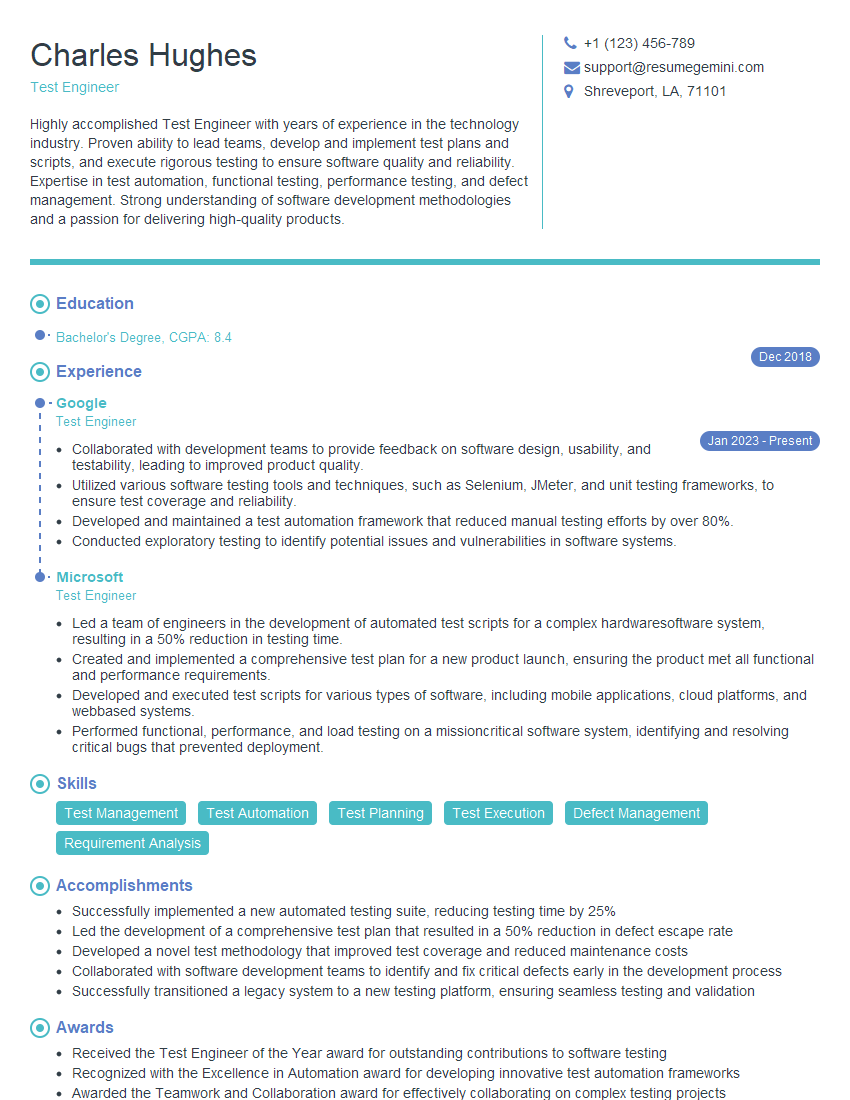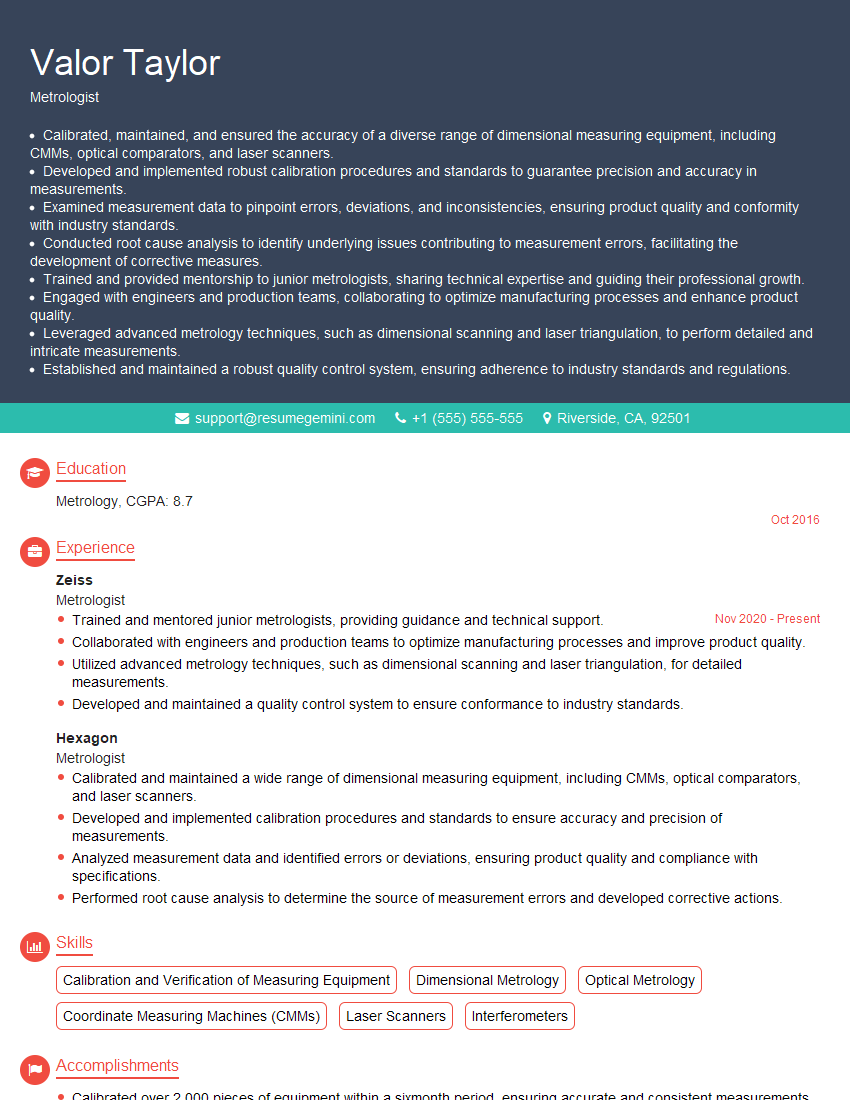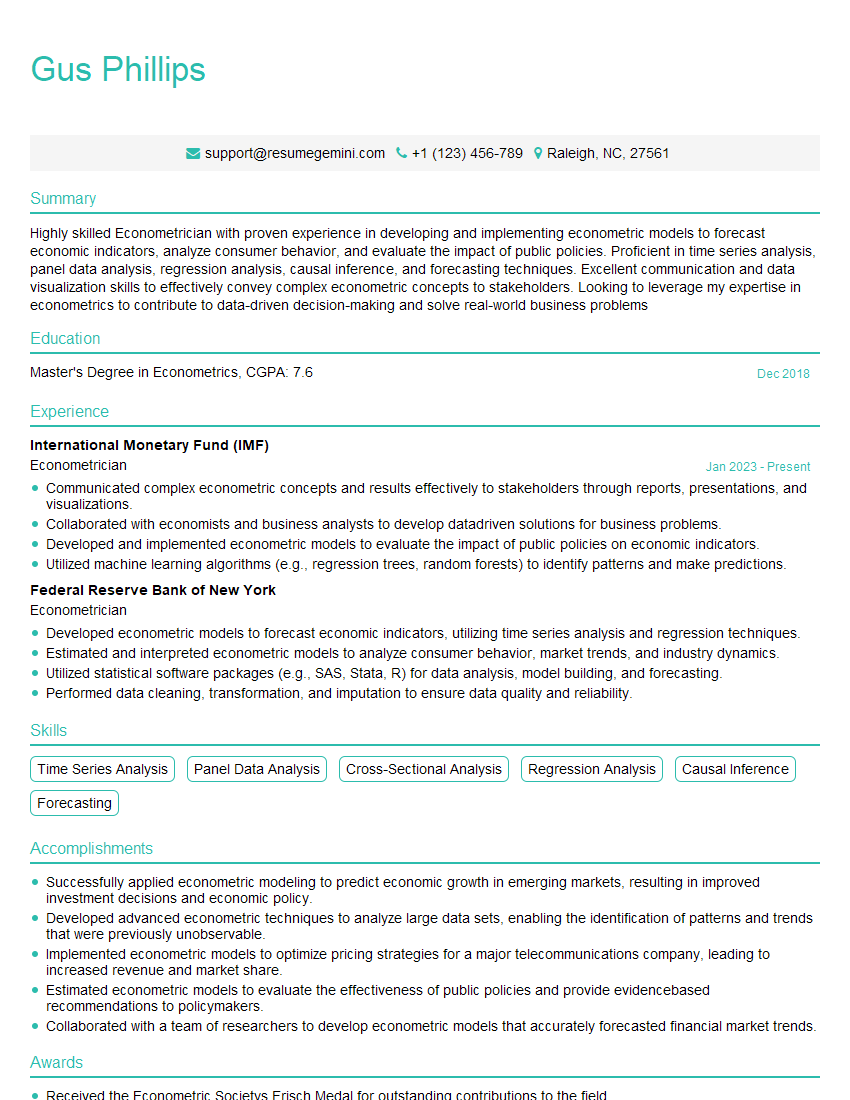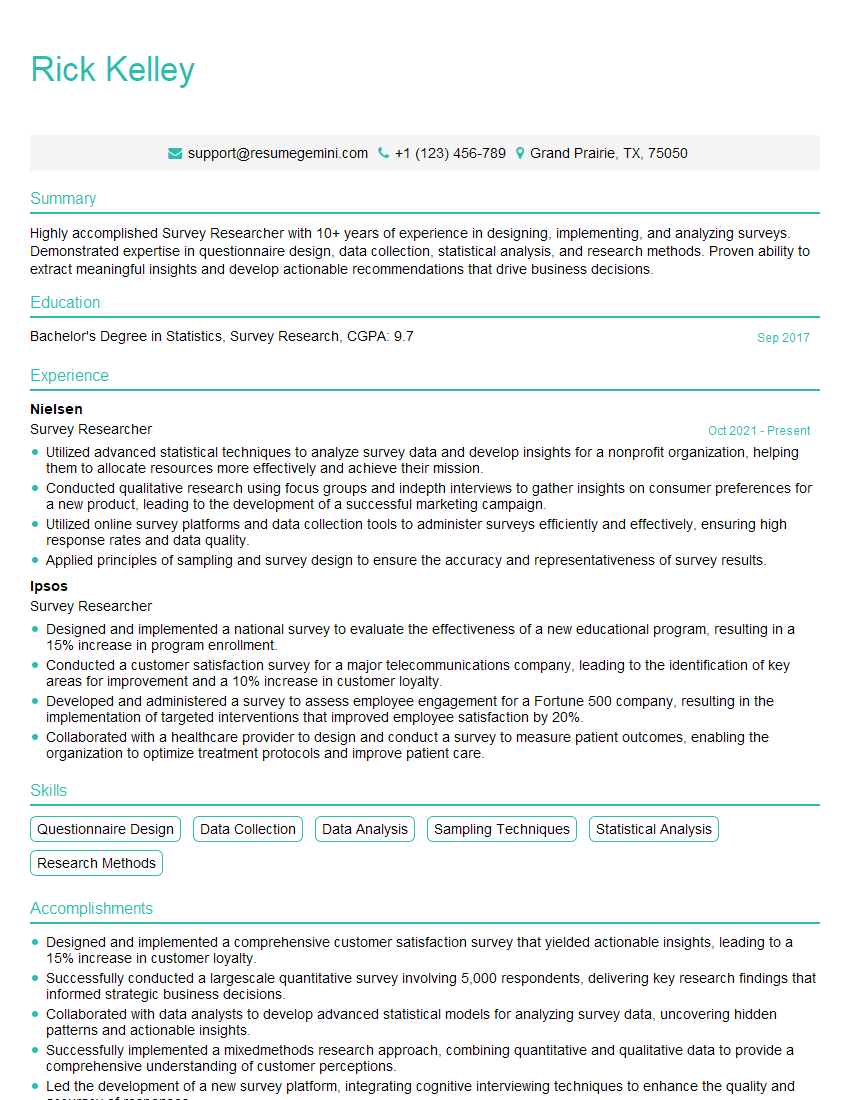Feeling uncertain about what to expect in your upcoming interview? We’ve got you covered! This blog highlights the most important Measurement Skills interview questions and provides actionable advice to help you stand out as the ideal candidate. Let’s pave the way for your success.
Questions Asked in Measurement Skills Interview
Q 1. Explain the difference between accuracy and precision in measurement.
Accuracy and precision are two crucial aspects of measurement, often confused but distinct. Accuracy refers to how close a measurement is to the true or accepted value. Precision, on the other hand, refers to how close repeated measurements are to each other. Think of it like archery: a highly accurate archer hits the bullseye consistently, while a highly precise archer might not hit the bullseye but consistently hits the same spot on the target, even if it’s off-center.
For example, if the true length of a table is 1 meter, an accurate measurement might be 1.01 meters, while a precise but inaccurate measurement might be consistently recorded as 1.05 meters, 1.06 meters, 1.05 meters across multiple attempts. High accuracy and high precision are the ideal, indicating a reliable measurement process. Low accuracy and low precision indicates significant problems with the measurement technique.
Q 2. Describe various types of measurement scales (nominal, ordinal, interval, ratio).
Measurement scales categorize the nature of data. They are:
- Nominal Scale: This scale categorizes data into distinct groups without any inherent order or ranking. Examples include gender (male, female), eye color (blue, brown, green), or types of fruit (apple, banana, orange).
- Ordinal Scale: This scale categorizes data into ranked categories, but the difference between categories isn’t necessarily consistent. For instance, customer satisfaction ratings (very satisfied, satisfied, neutral, dissatisfied, very dissatisfied) are ordinal because we know the order, but the difference between “very satisfied” and “satisfied” might not be the same as between “satisfied” and “neutral”.
- Interval Scale: This scale has ordered categories with consistent intervals between them, but it lacks a true zero point. Temperature in Celsius or Fahrenheit is a good example. The difference between 20°C and 30°C is the same as between 30°C and 40°C, but 0°C doesn’t represent the absence of temperature.
- Ratio Scale: This scale is similar to the interval scale, but it includes a true zero point that represents the absence of the measured quantity. Height, weight, age, and income are examples of ratio scales. A height of 0 means no height; zero weight means no weight. This allows for meaningful ratios (e.g., someone twice as tall as another).
Q 3. What are the common sources of measurement error?
Measurement errors can stem from various sources:
- Random Error: These are unpredictable fluctuations in measurements that are equally likely to be positive or negative. They are usually small and tend to cancel each other out over many measurements. They arise from limitations of the instrument’s precision or environmental factors.
- Systematic Error: These errors are consistent and predictable, often caused by a flaw in the measurement instrument or procedure. For example, a consistently biased scale would introduce a systematic error.
- Observer Error: Mistakes made by the person taking the measurement, such as misreading a scale or recording data incorrectly.
- Instrument Error: Errors caused by inaccuracies or limitations in the measuring instrument itself, such as a faulty calibration or worn-out components.
- Environmental Error: Errors due to external factors, such as temperature, humidity, or vibrations, affecting the measurement.
Q 4. How do you handle outliers in a dataset?
Outliers are data points significantly different from other observations. Handling them requires careful consideration:
- Identify Outliers: Use visual methods (box plots, scatter plots) or statistical methods (Z-scores, IQR). A Z-score beyond ±3 standard deviations is often considered an outlier.
- Investigate the Cause: Try to determine if the outlier is due to a measurement error, a data entry mistake, or a genuine anomaly. Investigating could involve reviewing the data collection process, re-measuring the data point, or considering any unique circumstances affecting that particular observation.
- Handle Appropriately: If an outlier is a genuine data point with a valid reason for being unusual, it may be retained. If it is a clear error, it should be corrected or removed. Otherwise, depending on the statistical technique being used, one may choose to transform the data (e.g., logarithmic transformation), use robust statistical methods less sensitive to outliers (median instead of mean), or winsorize or trim the data.
For instance, in a study of salaries, an individual earning millions of dollars would likely be an outlier if everyone else earned a significantly smaller amount. An investigation is required before removing it to determine if it represents a genuine data point or an error.
Q 5. Explain the concept of statistical significance.
Statistical significance refers to the likelihood that an observed effect is not due to random chance but is a true effect. It is usually expressed as a p-value. A low p-value (typically below 0.05) indicates that the observed results are unlikely to have occurred by chance alone and suggests a statistically significant effect. The significance level (alpha), often set at 0.05, defines the threshold. If the p-value is less than alpha, we reject the null hypothesis (the assumption of no effect). However, statistical significance doesn’t necessarily imply practical significance or real-world importance.
For example, suppose a study shows a new drug reduces blood pressure with a p-value of 0.01. This is statistically significant, suggesting the drug’s effectiveness is unlikely due to random chance. However, the magnitude of the blood pressure reduction must also be considered to assess its practical significance. A tiny statistically significant reduction might be of little clinical importance.
Q 6. What is a confidence interval, and how is it calculated?
A confidence interval provides a range of values within which the true population parameter (e.g., mean, proportion) is likely to fall, with a specified level of confidence (e.g., 95%). It reflects the uncertainty associated with estimating the parameter from a sample.
A 95% confidence interval means that if we were to repeat the sampling process many times, 95% of the calculated intervals would contain the true population parameter. The calculation generally involves the sample statistic (e.g., sample mean), the standard error (a measure of the variability of the sample statistic), and the critical value from the appropriate distribution (often the Z-distribution or t-distribution).
Confidence Interval = Sample Statistic ± (Critical Value * Standard Error)
For example, a 95% confidence interval for the average height of women might be 165 cm ± 2 cm, indicating that we are 95% confident that the true average height falls between 163 cm and 167 cm.
Q 7. How do you choose the appropriate statistical test for a given dataset and research question?
Choosing the appropriate statistical test depends on several factors:
- Type of Data: Nominal, ordinal, interval, or ratio.
- Number of Groups: One, two, or more.
- Research Question: Are you comparing means, proportions, or examining relationships between variables?
- Assumptions of the Test: Are the data normally distributed? Are the variances equal across groups?
Here’s a simplified guide:
- Comparing means of two groups with normally distributed data and equal variances: Independent samples t-test.
- Comparing means of two groups with normally distributed data but unequal variances: Welch’s t-test.
- Comparing means of three or more groups: ANOVA (analysis of variance).
- Comparing proportions of two groups: Chi-squared test or Z-test for proportions.
- Examining relationships between two continuous variables: Pearson correlation.
- Examining relationships between two categorical variables: Chi-squared test.
It’s crucial to consult a statistician or use statistical software to ensure the most appropriate test is used, given the specific characteristics of the data and research question.
Q 8. What is the difference between a t-test and an ANOVA test?
Both t-tests and ANOVAs are statistical tests used to compare means, but they differ in the number of groups being compared. A t-test compares the means of two groups. Think of it like deciding whether two different fertilizers significantly impact plant growth. An ANOVA (Analysis of Variance), on the other hand, compares the means of three or more groups. Imagine testing the plant growth with not just two fertilizers, but five different ones.
The t-test is simpler and looks at the difference between two group averages. ANOVA is more complex and assesses variance within and between groups. A significant ANOVA result only tells you there’s a difference somewhere among the groups; you need post-hoc tests (like Tukey’s HSD) to pinpoint where those differences lie. In essence, a t-test is a special case of ANOVA when you only have two groups.
- T-test: Compares two group means.
- ANOVA: Compares three or more group means.
Q 9. Explain regression analysis and its applications in measurement.
Regression analysis is a powerful statistical method used to model the relationship between a dependent variable and one or more independent variables. Imagine you’re trying to predict house prices (dependent variable) based on factors like size, location, and age (independent variables). Regression analysis helps establish this relationship mathematically, allowing you to predict house prices based on the values of the independent variables.
In measurement, regression is incredibly valuable. For instance:
- Calibration: We can use regression to create a calibration curve for a measuring instrument, relating instrument readings to the true values. This improves the accuracy of our measurements.
- Predictive Modeling: Regression helps predict future measurements based on historical data. For example, we might predict the yield of a crop based on weather patterns and soil conditions.
- Error Analysis: Regression can be used to analyze measurement errors and identify potential sources of bias.
Different types of regression exist, such as linear regression (for linear relationships), polynomial regression (for curved relationships), and multiple regression (for more than one independent variable).
Q 10. Describe your experience with different data visualization techniques.
My experience spans a variety of data visualization techniques, tailoring my approach to the specific data and audience. I’m proficient in using:
- Histograms: To display the distribution of a single continuous variable.
- Scatter plots: To show the relationship between two continuous variables.
- Box plots: To compare the distribution of a variable across different groups.
- Bar charts: To compare the values of a categorical variable across different groups.
- Line graphs: To display trends over time or across continuous variables.
- Heatmaps: To represent data in a matrix format, showing the intensity of data points using color.
Choosing the right visualization is crucial for effective communication. For example, while a histogram might show the distribution of measurement errors, a scatter plot might reveal a correlation between two measurement parameters.
Q 11. How do you ensure the reliability and validity of your measurements?
Ensuring the reliability and validity of measurements is paramount. Reliability refers to the consistency of measurements – do we get the same result if we repeat the measurement? Validity refers to whether the measurement actually measures what it’s intended to measure. They are distinct but interconnected.
To ensure reliability, I employ techniques such as:
- Test-retest reliability: Repeating the measurement on the same subject under the same conditions.
- Inter-rater reliability: Having multiple observers make the measurement and comparing their results.
- Internal consistency reliability (Cronbach’s alpha): Assessing the consistency of multiple items within a measurement instrument (e.g., a questionnaire).
To ensure validity, I focus on:
- Content validity: Does the measurement comprehensively cover all aspects of the concept being measured?
- Criterion validity: Does the measurement correlate with an established gold-standard measure?
- Construct validity: Does the measurement accurately reflect the underlying theoretical construct?
Regular instrument calibration and thorough documentation of procedures also contribute to both reliability and validity.
Q 12. Explain the concept of standardization in measurement.
Standardization in measurement involves transforming raw data into a common scale, allowing for meaningful comparisons across different datasets or individuals. This is crucial when comparing measurements obtained using different instruments, methods, or scales. A simple example is converting temperatures from Celsius to Fahrenheit – both measure the same thing (temperature), but on different scales. Standardization makes the data comparable.
Common standardization techniques include:
- Z-score standardization: Transforming data to have a mean of 0 and a standard deviation of 1. This centers the data around zero and scales it by the standard deviation.
- Min-max standardization: Scaling data to a specific range, typically between 0 and 1. This is useful when the scale of the data is not important, but rather the relative positions of the data points.
Standardization is essential for many statistical analyses, as it ensures that variables with different scales contribute equally to the analysis. For instance, in regression, it prevents variables with larger values from dominating the model.
Q 13. How do you interpret correlation coefficients?
Correlation coefficients, such as Pearson’s r, quantify the strength and direction of the linear relationship between two variables. The value ranges from -1 to +1.
- +1: Perfect positive correlation. As one variable increases, the other increases proportionally.
- 0: No linear correlation. There’s no linear relationship between the variables.
- -1: Perfect negative correlation. As one variable increases, the other decreases proportionally.
The closer the absolute value of the coefficient is to 1, the stronger the relationship. For example, a correlation coefficient of 0.8 indicates a strong positive relationship, while a coefficient of -0.7 indicates a strong negative relationship. It’s crucial to remember that correlation does not imply causation – a strong correlation simply suggests an association, not necessarily that one variable causes changes in the other.
Q 14. What are some common methods for data cleaning and preprocessing?
Data cleaning and preprocessing are crucial steps before any analysis. They improve data quality and ensure the accuracy of the results. Common methods include:
- Handling missing values: This can involve imputation (filling in missing values using techniques like mean imputation or more sophisticated methods), or removal of rows/columns with excessive missing data. The choice depends on the nature and extent of missing data.
- Outlier detection and treatment: Outliers are extreme values that can skew results. Detection methods include box plots, z-score analysis and scatter plots. Treatment could involve removal, transformation (log transformation, etc.), or winzorization.
- Data transformation: Converting data to a more suitable format. This could be changing data types (e.g., converting text to numerical), standardizing or normalizing data, or applying logarithmic or other transformations to address skewness.
- Data consistency checks: Ensuring consistency in data entry, such as using consistent units or formats. This might involve identifying and correcting inconsistencies or duplicates.
The specific techniques used depend on the nature of the data and the goals of the analysis. Thorough data cleaning is vital to avoid errors and biases in subsequent analyses.
Q 15. Describe your experience working with large datasets.
Working with large datasets is a common task in my field. My experience involves leveraging various techniques to manage, analyze, and extract meaningful insights from datasets containing millions of data points. This often requires a multi-step process. First, I assess the dataset’s structure and characteristics to determine the most appropriate analytical methods. Then, I employ tools like SQL and programming languages such as Python (with libraries like Pandas and Dask) or R to efficiently handle the data volume. These tools allow for parallel processing and optimized memory management, crucial for avoiding system crashes and ensuring timely analysis. For example, in a recent project involving customer transaction data exceeding 10 million records, I used Dask to perform data aggregation and statistical modelling, dividing the dataset into smaller, manageable chunks for processing. The result was a significant speed increase compared to processing the entire dataset at once.
Furthermore, I have extensive experience with cloud computing platforms like AWS or Azure, which provide scalable storage and computational resources ideal for handling extremely large datasets that exceed the capacity of local machines. Finally, careful data cleaning and feature engineering are essential to ensure data quality and reduce noise before advanced analysis.
Career Expert Tips:
- Ace those interviews! Prepare effectively by reviewing the Top 50 Most Common Interview Questions on ResumeGemini.
- Navigate your job search with confidence! Explore a wide range of Career Tips on ResumeGemini. Learn about common challenges and recommendations to overcome them.
- Craft the perfect resume! Master the Art of Resume Writing with ResumeGemini’s guide. Showcase your unique qualifications and achievements effectively.
- Don’t miss out on holiday savings! Build your dream resume with ResumeGemini’s ATS optimized templates.
Q 16. How do you handle missing data in a dataset?
Missing data is a prevalent issue in real-world datasets. The best approach depends on the nature and extent of the missing data, as well as the characteristics of the dataset itself. A key initial step is understanding *why* the data is missing. Is it Missing Completely at Random (MCAR), Missing at Random (MAR), or Missing Not at Random (MNAR)? This understanding guides the chosen imputation method.
- For MCAR data, simple methods like mean/median/mode imputation might suffice, although this can distort the variance and skew results. More robust methods include using k-Nearest Neighbors (k-NN) to find similar observations to impute values.
- For MAR and MNAR data, more sophisticated techniques are necessary. Multiple imputation, which generates multiple plausible imputed datasets, offers a better way to handle this. This accounts for the uncertainty introduced by imputation. Other advanced approaches involve model-based imputation, leveraging regression or maximum likelihood estimation to predict missing values based on the observed data and the relationships between variables.
Always document the method used for missing data imputation, and consider performing sensitivity analysis to assess the robustness of the results to different imputation strategies.
Q 17. What are some ethical considerations in data collection and analysis?
Ethical considerations in data collection and analysis are paramount. They guide responsible data handling and ensure fairness, privacy, and transparency. Key ethical considerations include:
- Informed Consent: Participants must be fully informed about the purpose of data collection, how their data will be used, and their right to withdraw.
- Privacy: Data must be anonymized or pseudonymized to protect individual identities. Strict adherence to data protection regulations (like GDPR or HIPAA) is vital.
- Data Security: Robust security measures must be in place to prevent unauthorized access, use, or disclosure of data.
- Bias and Fairness: Carefully consider potential biases in data collection and analysis methods. Ensure algorithms and models do not perpetuate existing societal inequalities.
- Transparency and Accountability: Document all stages of the data analysis process, including data cleaning, feature selection, and modeling choices. This allows others to scrutinize the results and understand any limitations.
Failing to address these ethical considerations can lead to inaccurate conclusions, discrimination, and reputational damage. It’s crucial to establish ethical guidelines at the beginning of any data project.
Q 18. How do you communicate complex quantitative information to a non-technical audience?
Communicating complex quantitative information to a non-technical audience requires simplifying technical jargon and using clear, concise language. Visualizations are key; charts and graphs can convey complex patterns and trends much more effectively than raw numbers. I use a storytelling approach, building a narrative around the data to make it relatable and engaging. For example, instead of saying ‘The regression model showed a statistically significant positive correlation between variable X and Y (p < 0.05)', I might say, 'Our analysis shows a clear link between X and Y: as X increases, Y tends to increase as well.' I often use analogies to explain abstract concepts; if the audience is familiar with a particular topic, I'll relate the statistical concepts to their everyday understanding. I also prioritize interactive dashboards and tools that allow non-technical users to explore data and draw their own conclusions.
Finally, I always start by understanding the audience’s background knowledge and tailoring my communication accordingly. I avoid technical terms unless necessary and define them when used.
Q 19. Explain your experience with different statistical software packages (e.g., R, SPSS, SAS).
I’m proficient in several statistical software packages. My primary tools are R and Python. R’s strength lies in its statistical computing capabilities and vast libraries (like ggplot2 for visualization, dplyr for data manipulation, and caret for machine learning). I use Python, particularly with its Pandas and Scikit-learn libraries, for its flexibility in handling large datasets, performing data wrangling, and building machine learning models. I have also worked with SPSS and SAS in previous projects, primarily for their robust capabilities in statistical testing and reporting. My choice of software often depends on the project’s specific needs and the nature of the dataset. For example, for a large-scale machine learning project involving high-dimensional data, I would likely choose Python for its scalability and optimized libraries, whereas for a smaller project requiring specific statistical tests readily available in a user-friendly interface, I might opt for SPSS.
Q 20. Describe a time you identified a significant measurement error and how you corrected it.
In a previous project involving measuring customer satisfaction, we initially relied on a survey that included a leading question. This resulted in an artificially inflated satisfaction score. I identified this measurement error by comparing our results to similar studies and noticing a significant discrepancy. I also performed a qualitative analysis of the open-ended survey responses, which revealed respondents’ frustration with a specific aspect of the service, a frustration not reflected in the leading question’s overly positive quantitative results. To correct this, we revised the survey instrument to remove the leading question and included more balanced questions focusing on specific aspects of customer experience. We then re-administered the revised survey, resulting in a more accurate and reliable measurement of customer satisfaction. The new data reflected the true sentiment more accurately, allowing for better informed decision-making regarding service improvements.
Q 21. How do you determine the appropriate sample size for a study?
Determining the appropriate sample size is crucial for ensuring the reliability and validity of a study’s findings. Several factors influence sample size determination, including:
- The desired level of precision (margin of error): A smaller margin of error requires a larger sample size.
- The desired level of confidence (confidence interval): A higher confidence level requires a larger sample size.
- The expected variability in the population (standard deviation): Higher variability requires a larger sample size.
- The effect size: Smaller effect sizes require larger sample sizes to be detected.
- The type of analysis: Different statistical analyses may require different sample sizes.
Various methods can calculate sample size, such as power analysis, which involves using statistical software to determine the minimum sample size needed to achieve a desired level of statistical power. There are online calculators and statistical software packages (like G*Power or R’s pwr package) that facilitate sample size calculation. For instance, pwr.t.test(d = 0.5, sig.level = 0.05, power = 0.80, type = 'two.sample') in R calculates the sample size needed for a two-sample t-test with a medium effect size (d=0.5), a significance level of 0.05, and a power of 0.80. The results provide the required sample size for each group.
Ultimately, selecting an appropriate sample size is a balance between the resources available and the need for statistically significant and reliable results.
Q 22. What is your experience with A/B testing and experimental design?
A/B testing, also known as split testing, is a randomized experiment where two versions of a variable (e.g., a website headline, an email subject line) are compared to determine which performs better. Experimental design is the process of planning and conducting this test to ensure valid and reliable results. My experience encompasses designing experiments, selecting appropriate sample sizes, and analyzing the results to draw statistically sound conclusions.
For instance, in a previous role, we A/B tested two different call-to-action buttons on a landing page. One button used strong action verbs, and the other used softer language. We randomly assigned users to see either version, collected click-through rates, and used a statistical test (like a t-test) to determine if there was a statistically significant difference in performance. This rigorous process helped us make data-driven decisions about improving conversion rates. My approach always emphasizes using a well-defined hypothesis, controlling for confounding variables, and employing appropriate statistical methods to avoid false positives or negatives.
Q 23. Explain your understanding of different types of bias in measurement.
Measurement bias refers to systematic errors that lead to inaccurate or misleading results. Several types exist:
- Selection bias occurs when the sample used isn’t representative of the population being studied. For example, surveying only high-income individuals to understand consumer preferences for a new product introduces bias because their preferences may differ significantly from those of lower-income consumers.
- Measurement bias arises from flaws in the measurement instrument or the way the measurement is taken. A poorly worded survey question can lead to inaccurate responses. Using a faulty scale to measure weight leads to inaccurate weight readings.
- Observer bias happens when the observer’s expectations influence the measurements. If a researcher knows the treatment group, they might unintentionally record results favorably towards that group.
- Response bias is introduced by the respondents themselves. For example, social desirability bias leads people to answer questions in a way that makes them appear more socially acceptable, even if it’s not truthful.
Understanding these biases is crucial because they can severely compromise the validity and reliability of any measurement.
Q 24. How do you ensure the quality of your data sources?
Ensuring data quality is paramount. My approach is multi-faceted:
- Data Source Validation: I rigorously assess the credibility and reliability of each data source. This involves checking the source’s reputation, methodology, and the potential for bias. I look for documentation about data collection procedures and any known limitations.
- Data Cleaning and Transformation: Raw data rarely arrives in perfect condition. I utilize techniques like outlier detection, missing value imputation, and data transformation to ensure the data is consistent, accurate, and suitable for analysis.
- Data Validation Checks: I employ various checks to identify inconsistencies or anomalies in the data. This may involve cross-referencing information across multiple sources or using data consistency checks. Range checks and plausibility checks are frequently employed.
- Documentation: Meticulous documentation of data sources, cleaning processes, and any transformations made ensures transparency and reproducibility. It’s crucial to maintain an audit trail of any changes to the data.
By implementing these steps, I can build confidence in the reliability of my analyses.
Q 25. What metrics would you use to measure the success of [specific project/campaign]? (adapt to the specific role)
Let’s assume the project is a new marketing campaign for a mobile app. The metrics I’d use to measure success would depend on the campaign’s goals but could include:
- App Downloads/Installs: A direct measure of campaign effectiveness in driving user acquisition.
- Cost Per Install (CPI): This metric helps assess the campaign’s efficiency in terms of cost.
- Daily/Monthly Active Users (DAU/MAU): Indicates user engagement after installation.
- Customer Lifetime Value (CLTV): Predicts the revenue generated from each acquired user over their time with the app.
- Retention Rate: Measures how well the campaign attracts users who stick around.
- Conversion Rate (e.g., from free to paid users): Monitors the success of in-app monetization strategies.
- Brand Awareness Metrics (social media engagement, website traffic): Tracks the campaign’s impact on brand visibility.
I would use a combination of these metrics, chosen based on specific campaign objectives, to gain a comprehensive understanding of its success.
Q 26. Describe a situation where you had to make a decision based on incomplete data.
In a previous project involving forecasting customer churn, we were faced with incomplete data for a newly launched feature. We had historical churn data for established features, but not for this new one. Rather than delaying the decision, I proposed a tiered approach:
- Develop a baseline prediction: We used the existing historical data to create a model predicting churn based on common factors. This provided a conservative estimate.
- Sensitivity Analysis: We explored various scenarios, assuming different levels of potential impact from the new feature on churn. This gave us a range of possible outcomes.
- Qualitative Feedback Integration: We incorporated qualitative insights from user interviews and customer support interactions to inform our assumptions.
This strategy allowed us to make a data-informed decision, while acknowledging the limitations of the available data. The decision, while not perfectly precise due to the incomplete data, was better than inaction, and allowed us to make iterative improvements as more data became available.
Q 27. How familiar are you with different types of measurement instruments and their limitations?
I have extensive experience with various measurement instruments, including:
- Surveys: These can be questionnaires, interviews or focus groups, with limitations including response bias and potential for socially desirable answers.
- Scales: These include Likert scales, semantic differential scales, etc. used for measuring attitudes and opinions. Limitations include the potential for response set bias and issues with scale reliability.
- Physiological Measures: These include heart rate, blood pressure, brain activity (EEG, fMRI), and other biological signals. Limitations involve expense, invasiveness, and interpretation challenges.
- Behavioral Observation: This involves directly observing behaviors. Limitations include observer bias and the potential for reactivity (people changing their behavior when observed).
- Performance Metrics (e.g., website analytics, sales figures): These are objective measures of outcomes. Limitations may include data accuracy and the need for careful definition of metrics.
Understanding the strengths and weaknesses of each instrument is critical for choosing the right tool for the job and interpreting results appropriately.
Q 28. Explain your understanding of the central limit theorem.
The Central Limit Theorem (CLT) states that the distribution of the sample means of a large number of independent and identically distributed (i.i.d) random variables will approximate a normal distribution, regardless of the shape of the original population distribution. This is incredibly important in statistics.
Imagine you’re measuring the height of all students in a university. The actual distribution of heights might be skewed – more students might be clustered around average height with fewer extremely tall or short individuals. However, if you take many random samples of students and calculate the average height for each sample, the distribution of those average heights will be approximately normally distributed. The larger the sample size, the closer to normal the distribution will be. This allows us to use the properties of the normal distribution to make inferences about the population mean based on sample data, even when we don’t know the population distribution.
The CLT underpins many statistical tests and confidence intervals. It enables us to draw reliable conclusions about populations from samples, which is fundamental to much of statistical inference.
Key Topics to Learn for Measurement Skills Interview
- Data Collection Methods: Understanding various techniques like surveys, experiments, and observations, their strengths and weaknesses, and appropriate application based on research questions.
- Data Analysis Techniques: Proficiency in descriptive statistics (mean, median, mode, standard deviation), inferential statistics (hypothesis testing, regression analysis), and their practical application in interpreting data and drawing meaningful conclusions.
- Measurement Reliability and Validity: Understanding concepts like test-retest reliability, inter-rater reliability, and content validity. Knowing how to assess and improve the reliability and validity of measurement instruments.
- Error Analysis and Mitigation: Identifying potential sources of error in measurement processes (systematic vs. random error) and strategies to minimize their impact on results.
- Choosing Appropriate Measurement Scales: Understanding nominal, ordinal, interval, and ratio scales and selecting the most suitable scale for a given variable.
- Data Visualization: Ability to effectively communicate findings through appropriate charts, graphs, and tables. Understanding principles of clear and concise data visualization.
- Interpreting Results and Drawing Conclusions: Moving beyond raw data to articulate insights and implications based on statistical analysis and the context of the research question.
- Ethical Considerations in Measurement: Understanding and adhering to ethical principles related to data collection, analysis, and reporting, ensuring data privacy and integrity.
Next Steps
Mastering measurement skills is crucial for career advancement in many fields, opening doors to more challenging and rewarding roles. A strong foundation in these skills demonstrates your analytical abilities and problem-solving capabilities, making you a valuable asset to any organization. To maximize your job prospects, crafting an ATS-friendly resume is essential. ResumeGemini can help you build a professional and impactful resume that highlights your measurement skills effectively. Examples of resumes tailored to Measurement Skills are available within ResumeGemini to guide you.
Explore more articles
Users Rating of Our Blogs
Share Your Experience
We value your feedback! Please rate our content and share your thoughts (optional).
What Readers Say About Our Blog
Interesting Article, I liked the depth of knowledge you’ve shared.
Helpful, thanks for sharing.
Hi, I represent a social media marketing agency and liked your blog
Hi, I represent an SEO company that specialises in getting you AI citations and higher rankings on Google. I’d like to offer you a 100% free SEO audit for your website. Would you be interested?


